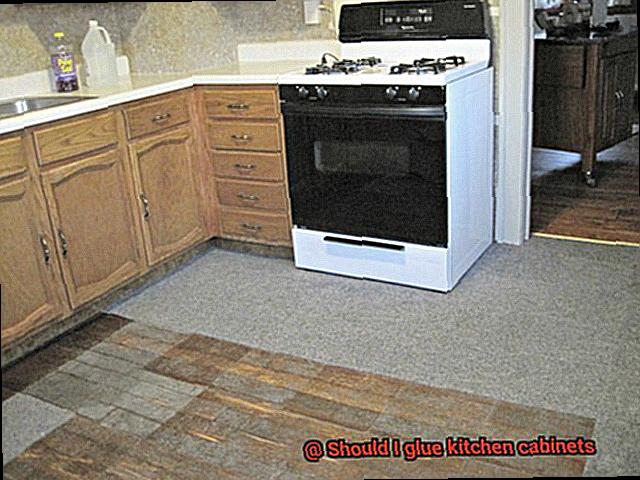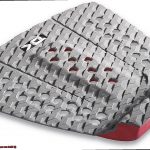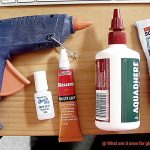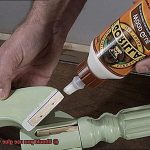Thinking about whether or not to glue your kitchen cabinets? Don’t worry, you’re not alone. Many homeowners face this dilemma when it comes to reinforcing their cabinets. So, should you grab that adhesive bottle and get to work? Let’s dive in and explore the pros and cons of gluing kitchen cabinets.
First off, gluing can provide some serious stability and durability to your cabinetry. By adding glue to the joints before screwing or bracketing them together, you’re creating a rock-solid bond that can handle the daily chaos of a busy kitchen. No more worrying about loose screws or wobbly cabinets.
But that’s not all – gluing also helps reduce those annoying creaks and squeaks that come with age. The adhesive acts like a superhero buffer, absorbing vibrations and friction that cause those irritating noises. Peaceful cooking vibes for the win.
And let’s not forget about heavy-duty cabinets. If you’ve got some oversized or weighty units, gluing is your secret weapon. With that extra adhesive reinforcement, you can rest easy knowing your cabinets will stay securely in place, no matter what you store inside.
Now, before you go on a gluing spree, there are a few things to consider. One major drawback is the irreversible nature of glue. Once it’s stuck, it’s stuck – making disassembly or adjustments a real challenge without causing damage to your precious cabinets.
Plus, not all materials play well with glue. If you’ve got particleboard or melamine cabinets, the adhesive might not stick as effectively, leaving you with less-than-ideal reinforcement.
And here’s another thing: if future renovations are on your mind, gluing may pose some problems down the line. Removing glued cabinets requires extra effort and could potentially damage other surfaces in the process.
So there you have it – gluing kitchen cabinets can bring added stability, durability, and peace and quiet to your cooking space. But it’s important to weigh the irreversible nature of glue, potential limitations with certain materials, and the challenges of future renovations.
When it comes to your cabinets, take your time, consider all the factors, and maybe even chat with a professional for some expert advice. Happy cabinet-ing.
Types of Cabinets and Their Benefits
Contents
- 1 Types of Cabinets and Their Benefits
- 2 Advantages of Gluing Kitchen Cabinets
- 3 Disadvantages of Gluing Kitchen Cabinets
- 4 How to Choose the Right Type of Glue
- 5 Preparing the Cabinet for Gluing
- 6 Applying the Glue Properly
- 7 Curing and Finishing the Glued Cabinet
- 8 Troubleshooting Common Issues with Gluing Kitchen Cabinets
- 9 Conclusion
When it comes to designing your dream kitchen, cabinets play a vital role in both functionality and aesthetics. Understanding the different types of cabinets available can help you make an informed decision that suits your budget, design preferences, and storage needs.
In this blog post, we will explore the various types of cabinets commonly used in kitchens and their respective benefits.
Stock Cabinets: The Affordable Option
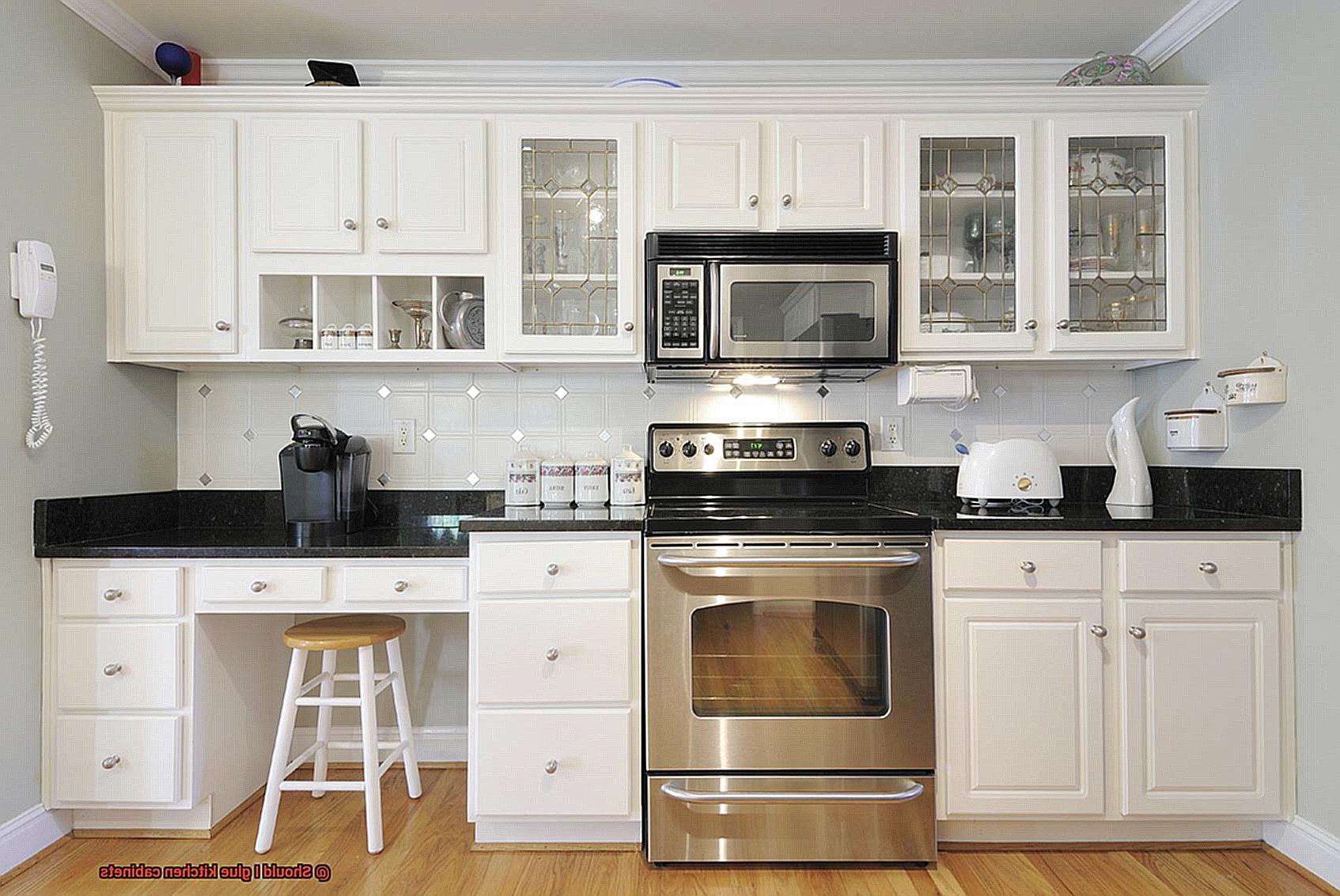
Stock cabinets are pre-made and readily available in standard sizes and styles. These cabinets are perfect for budget-conscious homeowners as they are typically less expensive than other options. While customization options may be limited, stock cabinets offer a quick and affordable solution for your kitchen remodeling needs.
Semi-Custom Cabinets: Flexibility on a Budget
Semi-custom cabinets strike a balance between stock and custom cabinets. They are partially pre-made but allow for customization to some extent. With semi-custom cabinets, you have the freedom to choose from a range of finishes, materials, and hardware options. This option provides more flexibility than stock cabinets while still being more affordable than fully custom cabinets.

Custom Cabinets: Tailored Perfection
For those seeking the ultimate level of personalization, custom cabinets are the way to go. Built from scratch according to your specifications, custom cabinets offer complete control over design, materials, finishes, and storage features. With custom cabinets, you can create a truly unique kitchen space that reflects your style and meets your specific needs.
Frameless Cabinets: Sleek and Modern
Frameless cabinets, also known as European-style cabinets, have gained popularity for their sleek and seamless look. Without a front frame, these cabinets maximize storage space and provide easy access to your kitchen essentials. Frameless cabinets are often associated with contemporary designs and are perfect for those aiming for a modern aesthetic.
Face-Frame Cabinets: Classic Elegance
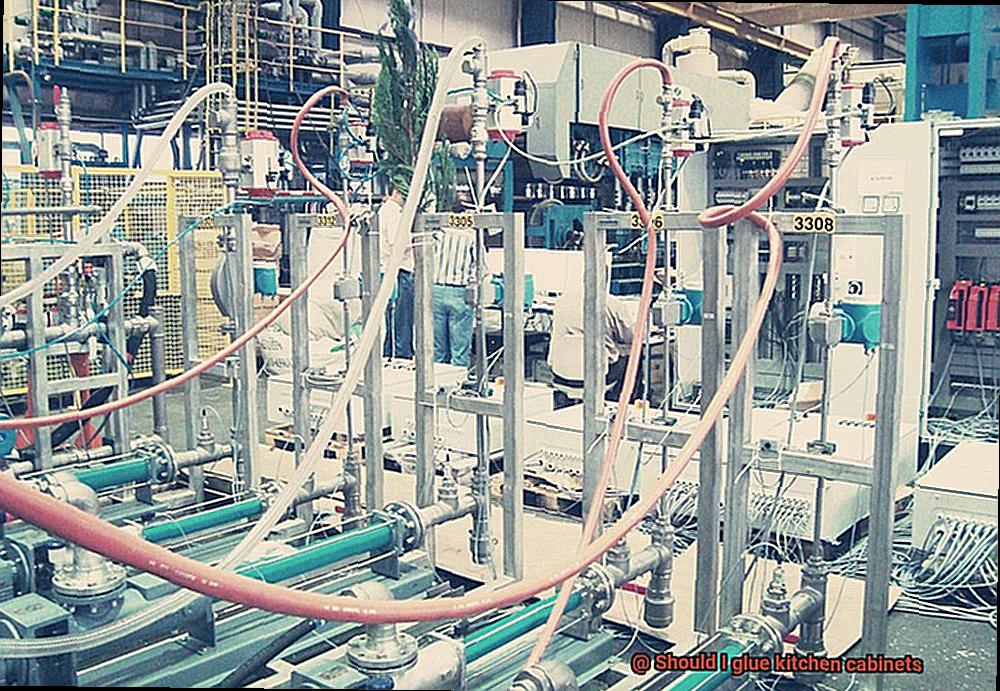
If you prefer a more traditional look, face-frame cabinets are a timeless choice. These cabinets feature a front frame that adds both structural stability and decorative appeal. With various door styles and finishes available, face-frame cabinets can be customized to match your desired aesthetic while maintaining their classic charm.
Choosing the right type of cabinet for your kitchen is an important decision that can greatly impact the overall look and functionality of the space.
Whether you opt for stock, semi-custom, or custom cabinets, each option comes with its own benefits and considerations.
Consider your budget, design preferences, and storage needs to select the perfect cabinets that will transform your kitchen into a beautiful and functional haven.
Advantages of Gluing Kitchen Cabinets
When it comes to kitchen cabinets, there’s a hidden gem that can elevate your cooking space to the next level – glue. Gluing kitchen cabinets offers a multitude of advantages that not only enhance the durability and stability of your cabinets but also add a touch of elegance to your overall design.
In this blog post, we’ll dive into the exciting world of glued kitchen cabinets and explore why they are the secret ingredient to creating a stunning kitchen.
Stability and Durability:
Gluing cabinets together provides a rock-solid foundation for your kitchen. The adhesive bond ensures that your cabinets remain stable, resistant to warping, shifting, and sagging over time.
This is especially crucial in high-traffic kitchens where cabinets endure constant use and heavy loads. Say goodbye to wobbly doors and misaligned drawers. With glued cabinets, you can have confidence in their ability to withstand the demands of a busy kitchen.
Sleek and Seamless Appearance:
One of the most significant advantages of gluing kitchen cabinets is the seamless appearance it creates. With no visible screws or nails on the exterior, your cabinets exude a sleek and polished look that will take your kitchen aesthetics to new heights. This clean and streamlined appearance adds sophistication and elegance to any kitchen design. Additionally, the absence of visible hardware makes cleaning and maintenance a breeze – no more dealing with dirt or grime trapped around screws.
Noise Reduction:
Opening and closing cabinet doors can sometimes create an unwanted ruckus in the kitchen. However, with glued cabinets, you can bid farewell to unnecessary noise disturbances. The adhesive used in the gluing process acts as a dampening agent, minimizing the sound produced when handling your cabinets. Enjoy a quiet and serene cooking experience in your open-concept kitchen without the clatter of cabinet doors disrupting the ambiance.
Design Flexibility:
Glued cabinets offer endless possibilities for customization. Without visible fasteners limiting your choices, you can explore various door styles, finishes, and hardware options to create a unique look for your kitchen.
Whether you prefer sleek and modern cabinets or traditional and rustic ones, gluing allows you the freedom to express your personal style and create a space that truly reflects your taste and personality.
Longevity and Cost Savings:
Glued cabinets are built to last. The strong bond created by the adhesive ensures that the joints remain secure and tight for years to come. This longevity saves you both time and money, as you’ll have fewer repairs or replacements to worry about in the future.
Investing in glued cabinets means investing in the long-term value of your kitchen, giving you peace of mind and cost savings in the long run.
Disadvantages of Gluing Kitchen Cabinets
Gluing kitchen cabinets may seem like a convenient and cost-effective solution, but it’s important to consider the disadvantages before making a decision. Let’s explore the drawbacks of gluing kitchen cabinets in detail, so you can make an informed choice for your home.
One major disadvantage of using glue to install kitchen cabinets is the difficulty of removal. Once cabinets are glued in place, they become firmly attached to the wall or floor. This means that if you ever need to replace or reposition the cabinets, it can be a labor-intensive and time-consuming process that risks damaging the surrounding surfaces.
Flexibility and customization are also limited when using glue for kitchen cabinets. With permanently attached cabinets, making changes such as adding or removing shelves, adjusting cabinet heights, or reconfiguring your kitchen layout becomes challenging. This lack of flexibility can be frustrating if your needs or preferences change over time.
Another issue with gluing cabinets is the potential for uneven surfaces. Depending on the type of glue used and the skill level of the installer, gaps between the cabinets and the wall or floor may occur. These gaps not only affect the aesthetics of your kitchen but also create spaces where dirt and debris can accumulate, making cleaning more challenging.
Moreover, glued joints may weaken or break over time due to wood expansion and contraction caused by temperature and humidity changes. This can result in loose or wobbly cabinets that require repairs or replacement sooner than expected.
It’s important to note that gluing kitchen cabinets may not be suitable for all materials. Some cabinet materials, like laminates or particleboard, may not hold up well with glue over time and may delaminate or warp. Before proceeding with gluing, consider the specific material of your cabinets.
Lastly, gluing cabinets can be a messy and potentially hazardous process. Many glue types emit strong fumes that can be harmful if inhaled excessively. It’s crucial to practice safety precautions, such as proper ventilation and wearing protective gear. Additionally, any spills or excess glue must be promptly cleaned up to avoid damage to the cabinets or surrounding areas.
How to Choose the Right Type of Glue
Choosing the right type of glue is crucial when working with kitchen cabinets. Using the wrong glue can result in weak joints, damage to the cabinets, and even health risks if it comes into contact with food. In this comprehensive guide, we will explore the key factors to consider when selecting the appropriate type of glue for your kitchen cabinets.
Consider the Materials:
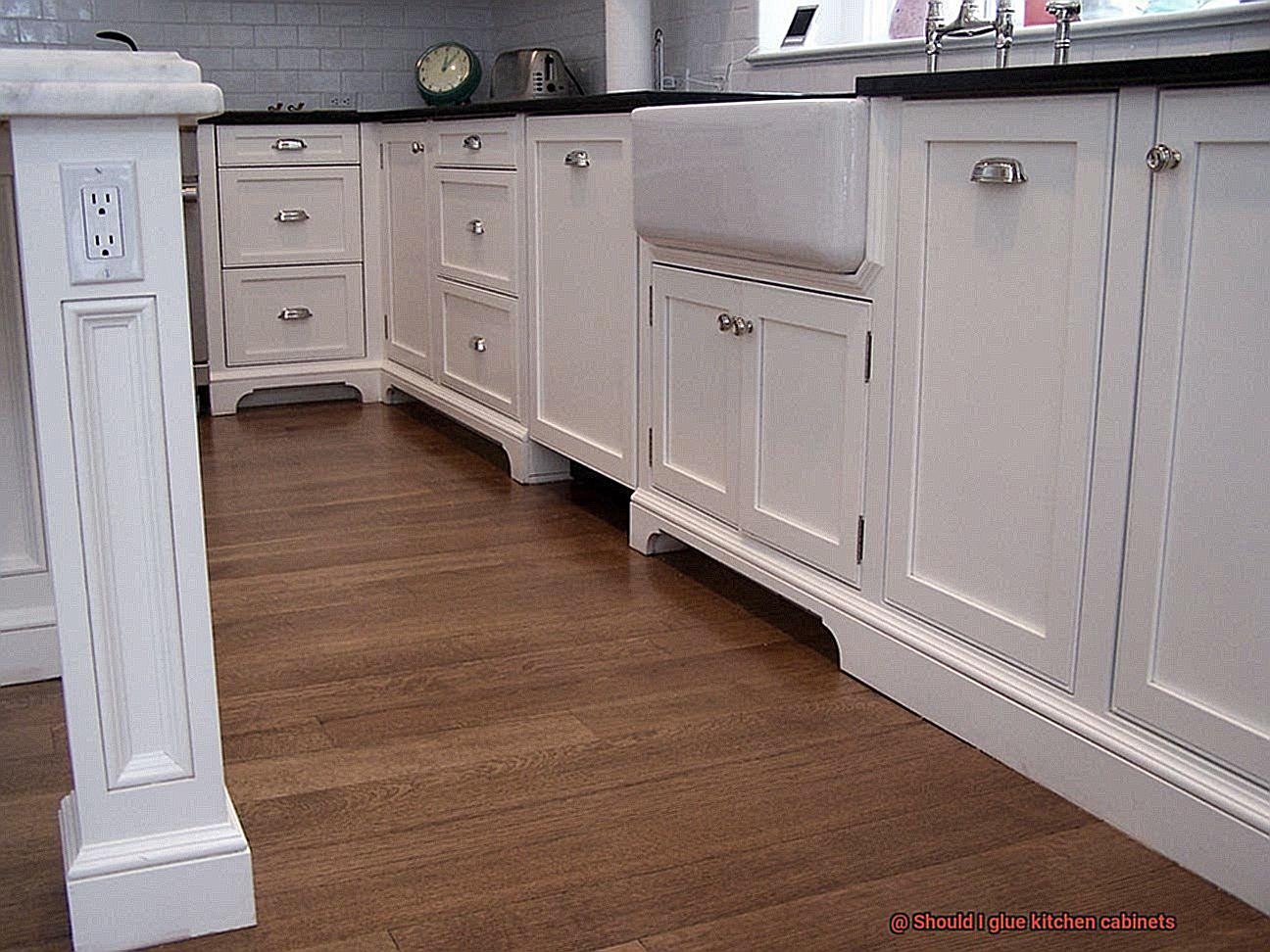
Different materials may need to be glued in kitchen cabinets, such as wood, laminate, or metal. It’s essential to choose a glue that is specifically designed for optimal adhesion to the material you are working with.
Wood Cabinets:
Wood glue, such as PVA (polyvinyl acetate) or aliphatic resin, is the most suitable option for wood cabinets. These wood glues offer strong bonding capabilities and can withstand temperature variations. They create durable bonds that can hold up well under the weight and stress placed on kitchen cabinets.
Laminate Cabinets:
Laminated surfaces require a different type of glue due to their smooth and non-porous finish. Contact cement or solvent-based adhesives specifically designed for laminates are recommended. These adhesives form strong bonds between the laminate and the underlying surface and are resistant to heat and moisture.
Metal Cabinets:
For metal cabinets, epoxy-based adhesives are often the best choice. Epoxy offers excellent bonding strength on metal surfaces. It can withstand heavy loads without losing its adhesive properties. Be sure to select an epoxy that is specifically designed for bonding metal surfaces.
Consider Environmental Factors:
Environmental factors such as humidity and exposure to water should also be taken into account when choosing glue for kitchen cabinets. Kitchens can be hot and humid environments, so it is crucial to select a glue that is resistant to moisture and heat. Look for adhesives that explicitly mention their ability to withstand these conditions.
Safety Considerations:
Prioritizing safety is essential when choosing glue for kitchen cabinets. Opt for low-VOC (volatile organic compound) or non-toxic glues to minimize health risks. Ensure proper ventilation when working with glue and always follow the manufacturer’s instructions.
Consultation with Professionals:
If you are unsure about the best glue choice for your specific cabinet materials or applications, consider seeking advice from professionals or experts in cabinetry or woodworking. They can provide valuable insights and recommend suitable adhesives based on your individual requirements.
Preparing the Cabinet for Gluing
Preparing a cabinet for gluing involves several steps to ensure a strong and secure bond. Let’s dive into the process:
- Cleaning the surfaces: Begin by wiping down the surfaces that will be glued together using a clean cloth and mild detergent. This step removes any dirt, dust, or grease that may hinder the glue from adhering properly.
- Sanding: Lightly sand the areas that will be glued together to create a rough texture. This allows the glue to penetrate the wood fibers effectively, resulting in a stronger bond. Remember to sand in the direction of the wood grain to avoid scratches or marks.
- Repairing any damage: Before applying glue, tighten any loose screws and fill in cracks or holes with wood filler. Also, replace any broken or missing pieces to ensure a solid and stable cabinet structure.
- Aligning and clamping: Align the surfaces that will be glued together and use clamps to hold them in place. This step ensures that the pieces are in the correct position and creates a tight bond. Apply the clamps evenly and securely, but be cautious not to overtighten them as it may cause warping.
- Dry fitting: Before applying glue, do a dry fit of the pieces to ensure they fit together properly. This helps identify any issues or adjustments needed before gluing and determines how much glue is required for each joint.
- Applying glue: Choose a high-quality glue specifically designed for woodworking. Apply a thin and even layer onto one of the surfaces using a brush or spreader. Avoid excessive glue as a little goes a long way.
- Pressing surfaces together: Carefully press the surfaces together, ensuring proper alignment. Do this step quickly as some glues set fast. Remove any excess glue with a damp cloth before it dries.
- Curing time: Leave the clamps in place for at least 24 hours to allow the glue to fully cure. This ensures a strong and secure bond between the cabinet pieces. Once cured, remove any remaining squeeze-out with a chisel or scraper.
Applying the Glue Properly
Imagine this: you’ve meticulously chosen the perfect kitchen cabinets to match your dream kitchen. The style, color, and design are all aligned with your vision. Now comes the crucial moment – assembling those cabinets and ensuring they withstand the test of time. One vital step in this process is applying the glue correctly. Let’s dive into why it’s so important and how to do it right.
Why is gluing kitchen cabinets such a big deal? Well, picture your cabinets collapsing under the weight of your favorite ceramic dishes or your beloved collection of antique teapots. Not a pretty picture, right? Properly applied glue creates a strong bond that can withstand the daily demands of a bustling kitchen.
To start off on the right foot, make sure to clean the surfaces that will be bonded. Grease, dirt, and residue can sabotage the glue’s effectiveness. Grab a mild detergent and water solution, give those surfaces a thorough wipe down, and dry them thoroughly.
Now let’s talk glue. Various types are available, but for woodworking projects like cabinet assembly, PVA glue is a popular choice. It’s strong, easy to work with, and readily available at most hardware stores.
When it comes to applying the glue, remember that less is more. Too little won’t provide a strong bond, while too much will create messy drips that are challenging to clean up. Aim for a thin, even layer on both surfaces that will be bonded.
Once you’ve applied the glue, it’s time to apply some pressure. This helps the glue cure and creates a tight connection between the surfaces. Clamps or heavy objects placed on top of the cabinets can do the trick.
Now comes the waiting game. Let the cabinets dry and cure for at least 24 hours before handling or installing them. This ensures that the glue sets properly and gives you optimal strength.
But wait, gluing may not always be necessary. Some cabinets come pre-assembled with secure joints. However, if you notice any signs of looseness or instability, adding some glue can provide that extra peace of mind.
Always read and follow the manufacturer’s instructions for the specific glue you’re using. Different glues have varying drying times, application techniques, and safety precautions. Ignoring these instructions could lead to less-than-ideal results.
Curing and Finishing the Glued Cabinet
Curing and finishing the glued cabinet is a critical step in the cabinet-making process. Curing refers to allowing the glue to dry and set completely, creating a strong bond between the cabinet pieces. Once the glue has fully cured, it’s time to add the finishing touches and enhance the appearance of your cabinets.
To properly cure the glued cabinet, it is essential to follow the manufacturer’s instructions for curing time. This time can vary depending on the type of glue used. During the curing process, it is crucial to keep the cabinets in a controlled environment with proper ventilation. Excessive moisture or humidity can prolong the curing time and result in weak bond strength.
While waiting for the glue to cure, take this opportunity to thoroughly clean the cabinets and remove any dust or debris that may have accumulated during the gluing process. A light sanding can also help create a smooth surface for better adhesion of the finish.
Once the glue has fully cured and your cabinets are clean and smooth, it’s time to move on to finishing. There are various types of finishes available, including paint, stain, varnish, lacquer, and polyurethane. The choice of finish will depend on your personal preference, desired look, and level of durability required for kitchen cabinets.
Before applying any finish, carefully read and follow the manufacturer’s instructions for application and drying time. It is recommended to apply multiple coats of finish, allowing each coat to dry completely before applying the next one. Proper drying time is crucial to ensure a durable and long-lasting finish.
Once your cabinets are fully finished and dried, they are ready to be installed in your kitchen. Admire your hard work and enjoy your beautiful new cabinets for years to come.
Troubleshooting Common Issues with Gluing Kitchen Cabinets
Gluing kitchen cabinets is a cost-effective and rewarding way to ensure their stability and longevity. However, there are common issues that can arise during the gluing process, which need to be addressed for optimal results. In this article, we will explore the different types of glue used for kitchen cabinets, potential problems that can occur with improper glue use, and provide troubleshooting tips for each issue.
Improper adhesive selection:
Not all adhesives are suitable for gluing kitchen cabinets. Regular wood glue may not withstand the moisture and temperature changes in a kitchen environment. To avoid this issue, choose an adhesive specifically designed for cabinet assembly, such as a water-resistant or waterproof adhesive.
Improper surface preparation:
Prepare the surfaces properly before applying any adhesive. Cleanliness is key – ensure the surfaces are clean, dry, and free from dust or grease. Remove any existing finish or varnish as it can prevent the adhesive from bonding properly. Lightly sanding the surfaces can also improve the bond.
Inadequate clamping pressure:
Apply sufficient pressure during the curing process for a strong bond. Insufficient pressure can result in weak joints that may fail over time. Use clamps or appropriate tools to evenly distribute pressure across the glued surfaces.
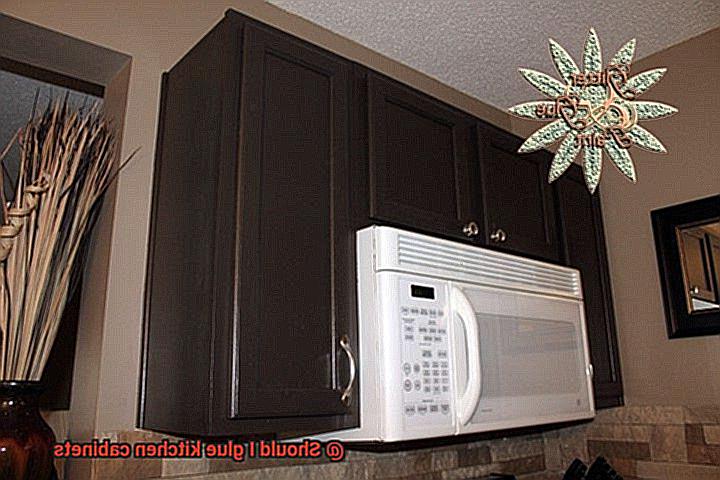
Uneven glue application:
Achieve a strong bond by applying an even layer of adhesive to both surfaces being glued together. Uneven application can lead to weak spots or gaps in the bond, compromising the overall strength of the cabinet joints.
Inadequate drying or curing time:
Follow the manufacturer’s instructions regarding drying and curing times for the adhesive being used. Rushing this process can result in weak joints that may fail over time. Patience is key when gluing kitchen cabinets.
Improper technique or lack of experience:
If unsure of your ability to glue kitchen cabinets, consider consulting a professional or seeking guidance from experienced individuals. They can provide valuable insights and tips to ensure a successful cabinet assembly.
zz55GWYTefo” >
Conclusion
When it comes to the question of whether or not you should glue kitchen cabinets, the answer is a resounding yes.
Gluing your cabinets can provide added stability and strength, ensuring that they stay firmly in place for years to come. Not only does this prevent any potential accidents or mishaps, but it also enhances the overall aesthetic appeal of your kitchen.
By using a strong adhesive specifically designed for woodworking, you can effectively bond the cabinet components together, creating a seamless and durable result.

